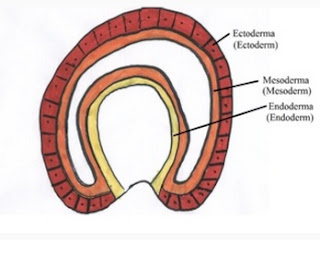Embryonic leaflets
An embryonic leaflet is the primary layer of cells that will subsequently give rise to all other tissues and organs of animals during the process of organogenesis. The three embryonic leaflets, or germ layers, form during embryogenesis and, in vertebrates, are particularly pronounced. However, all Eumetazoas produce two or three embryonic leaflets. Animals with radial symmetry, such as Cnidarians, produce two layers (the ectoderm and the endoderm) leading to the classification of diblásticos. Animals with bilateral symmetry produce a third camanda (the mesoderm), between the two other layers, leading to the classification of triblásticos.
They are formed in the second week of
development of the embryo in the process of Gastrulation, where the formation
of germ layers will occur.
Ectoderm will give rise to:
Epidermis and cutaneous attachments, all
structures of the nervous system (brain, nerves, nerve ganglia and spinal cord)
and epithelial lining of nasal, buccal and anal cavities.
The Mesoderm:
It forms the inner
layer of skin (dermis), smooth and skeletal muscles, circulatory system,
skeletal system, excretory system and reproductive system.
Endoderm:
Coating epithelium and
glands of the digestive tract, except for oral and anal cavity, respiratory
system (lung), liver and pancreas.
Referencia: MOORE, K. Embriologia Básica. 8ª Edição. Elsevier, 2013. 376p



Comentários
Postar um comentário